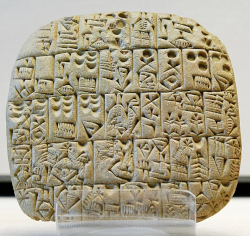Page 173
Writing Process Essays

Can a caterpillar instantly become a butterfly?
No. The metamorphosis takes time.
Can you instantly become an adult? Thank goodness, no!
Most wonderful transformations follow a process over time.
Imagine you want to bake yourself a splendid birthday cake. You start with eggs and flour and sugar and baking powder. You follow a recipe—measuring, mixing, pouring, baking, cooling, frosting. Only after following a process can you close your eyes and make a wish.
When you write a process essay, you explain just how to bake a cake, or just how a caterpillar becomes a butterfly. You lead readers step by step through a wonderful transformation!
What’s Ahead
WE 174
Page 174
Sample Process Essay
The following process essay was written by Drew Kattmann. Drew was interested in the history of writing and decided to focus on how the alphabet came into being. Notice how each paragraph focuses on a step in the process. Also notice that the sentences in each paragraph follow time order, going from start to finish.
How the Alphabet Came to Be
Drew Kattmann
Beginning
The first paragraph introduces the topic and provides the focus statement. The ABCs might seem simple, but they took thousands of years to develop. Our modern alphabet had its start in Ancient Egypt and Mesopotamia.

Middle
The middle paragraphs describe the process in time order. In 3000 B.C., Ancient Egypt had a written alphabet called hieroglyphics. Hieroglyphics were written on clay tablets by a select few called scribes. There were about 1,500 symbols that represented words and about 140 sound signs.
Transitions such as “When the Nile would flood” and “Around 650 B.C.” organize details by time. When the Nile would flood, it would leave silt deposits, making the land very fertile. One crop Egyptians grew was papyrus. Papyrus could be made into a type of paper, which led to a cursive script called hieratic. Hieratic was a much faster form of writing. The symbols were reduced to around 700. Around 650 B.C., a new script called demotic made writing more rapid, with 10 percent fewer symbols.
WE 175
Page 175

At the same time that Egyptians developed their alphabet, another civilization had a different approach.Public domain images help to explain the topic, with credit given. In 3000 B.C., Mesopotamia had a writing system called cuneiform. The Sumerians used sticks to press 2,000 different symbols into clay tablets. Cuneiform was used for tracking debt.
The writer uses many facts and dates to make the process clear. Both of these systems spread around the world, leading to new writing styles. For example, the Proto-Sinaitic inscriptions in Canaan date from 1800 B.C. They are considered the earliest form of alphabet writing, leading to all later forms.
In 1000 B.C., the Phoenician alphabet was created. This alphabet had only 22 symbols. The Phoenician alphabet was later the source of the Greek alphabet. After that came the Latin alphabet of Rome. In 700 C.E., missionaries used the Latin alphabet to replace the runes of Anglo-Saxon. That language became English.
Ending
The last paragraph sums up the process and provides a final thought. As you can see, the ABCs that we use now evolved over 5,000 years and in many different languages. The alphabet started with hieroglyphics and cuneiform and passed through Phoenician and Greek and Latin to become our current system. Our 26 letters came from many hundreds of symbols that took a variety of forms!
WE 176
Page 176
Writing a Process Essay
Prewriting Selecting a Topic
One type of process essay explains how something happens (or happened) over time. Think of explaining how something occurred in history or how a process takes place in nature.
How Tadpoles Become Frogs
1. A frog lays thousands of fertilized eggs in the water.
2. Tadpoles hatch, with tails and gills like fish.
3. Tadpoles eat, developing back legs and lungs.
4. Tadpoles grow front legs and shed their tails.
5. The frogs can now hop on land and swim in water.
Another type of process essay explains how to do something. It leads readers step by step through the process so that they can do it themselves. The tip below helps you come up with topic ideas for this type of essay.
Tip One way to find a topic is to use a list of verbs like the one below.
How to . . . fix . . . clean . . . build . . . throw . . . grow . . . play . . . make . . .
Then add whatever process comes to mind when you think of each verb.How to make . . . a pizza . . . a cake . . . a necklace . . . a music video . . . a friend . . .
Prewriting Gathering Details
Begin gathering details by listing everything you already know about your topic. Then search books, magazines, and websites to fill in any gaps. Even if you think you know how to do something, you’ll learn even more about the process by doing a little research. That will make your job easier and your essay more complete.
WE 177
Page 177
Prewriting Organizing Your Details
After you’ve chosen a topic and done a little research, you will want to make a list or a graphic organizer that covers each step in the process. Here’s what a list and a time line might look like for how the alphabet developed:
Numbered List
1. Egyptians used hieroglyphics, a picture language.
2. Hieroglyphics became hieratic and demotic writing.
3. Mesopotamians used cuneiform on clay.
4. These alphabets led to Phoenician.
5. Phoenician inspired Greek and Roman alphabets.
6. Latin letters replaced runes in Old English.
Time Line
3000 B.C. Hieroglyphics in Egypt; cuneiform in Mesopotamia
1800 B.C. Proto-Sinaitic inscriptions in Canaan
1000 B.C. Phoenician alphabet
900 B.C. Greek alphabet from Phoenician; first vowels
700 B.C. Latin alphabet from Greek and Egyptian
700 C.E. Latin alphabet replacing runes of Old English
WE 178
Page 178
Make an Outline
If your teacher asks you to do an outline instead of a list, you will need to decide which details are going to be in the first paragraph (I.), the second paragraph (II.), and so on. And remember, if you have an A, you should also have a B.
I. Ancient Egyptians had hieroglyphics.
A. Scribes wrote them on clay tablets.
B. They used more than 1,500 symbols.
C. About 140 symbols were sound signs.
II. Papyrus was like paper and led to easier writing.
A. Hieratic writing on papyrus was like cursive.
B. Hieratic writing developed into demotic writing.
III. Ancient Mesopotamians had a different system.
A. Cuneiform used sticks to press wedges into clay.
B. Cuneiform was used to track debts and other business.
IV. Hieroglyphs and cuneiform inspired other writing.
A. Proto-Sinaitic script was the first alphabet.
B. It began in 1800 B.C.
V. Phoenician writing started by 1000 B.C.
A. It led to the Greek alphabet in 900 B.C.
B. The Greek alphabet inspired the Latin alphabet in 700 B.C.
C. In 700 C.E. missionaries used the Latin alphabet to replace Anglo-Saxon runes.
D. Anglo-Saxon became English by 1500 C.E.
The outline shown above is a sentence outline. Your teacher may ask you to do a topic outline. That means instead of complete sentences you can use words or phrases to describe each step in the process.
WE 179
Page 179
Writing Developing the First Draft
Once you have organized your details, you are ready to write your first draft. Remember, this is just your first attempt to express your ideas; you’ll have a chance to revise later.
Beginning 🟪 The first paragraph should introduce your topic and give the reader background information about it. You should also let your reader know the overall focus of the essay. Will readers learn how to do something or how something works?
Middle 🟪 In the middle paragraphs, you need to explain the steps in the process as clearly as you can. Use a variety of different details to explain each step. (Consider adding a drawing or illustration if it would make the process clearer for the reader.)
Transitions 🟪 It’s also important that your middle paragraphs are tied together effectively. That means using transition or linking words that make it clear to the reader where you are in the process. Here are some of the most common transitions used to show time or chronological order.
Time-Order Transitions
first
next
then
finally
to start
secondly
continue by
afterward
last year
a week later
next month
by the end
before
at the same time
when
during
after
in 2024
Ending 🟪 Once you’ve explained all the steps in the process, it’s time to bring your essay to a close. In the final paragraph, you should summarize the key parts of the process and recap the result. Help readers understand what makes the process important.
WE 180
Page 180
Revising Elaborating Ideas
Once your first draft is finished, make sure that it is clear and complete. If you need more details, now is the time to add them. This is called elaborating. Consider using different kinds of details (facts, examples, explanations, etc.) to elaborate. Here is how Drew added an explanation in one paragraph to make a main point clearer.

Revising and Editing Improving Your Essay
You can use the following questions as a general guide when you revise and edit your essay. (For a more detailed editing checklist, see page 66.)
_____ Do I introduce my topic and identify the focus of my essay?
_____ Do I clearly explain each step in the process?
_____ Does my voice sound confident and knowledgeable?
_____ Do I bring everything to a logical conclusion in the final paragraph?
_____ Have I checked for any missing words or confusing sentences?
_____ Have I checked my essay for punctuation, grammar, and usage errors?
Publishing Sharing Your Essay
Once you have finished revising, editing, and proofreading your essay, you will want to make a final copy that is ready to share with others. Make sure that it is as error-free as possible and that any lists or illustrations are clear and in the right place.